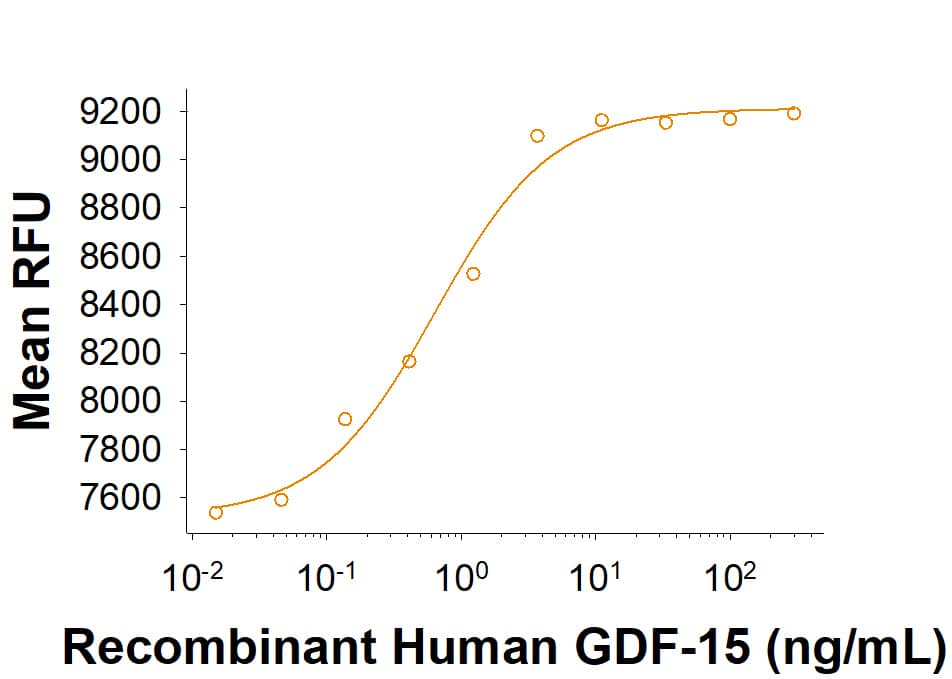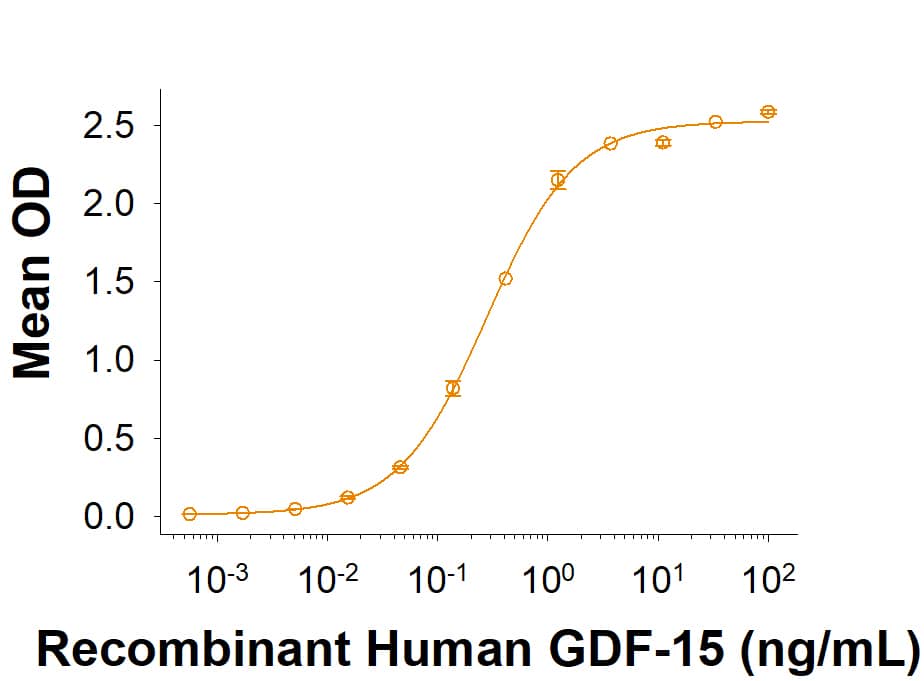Recombinant Human GDF-15 (CHO-expressed) Protein
R&D Systems, part of Bio-Techne | Catalog # 957-GD

Key Product Details
Product Specifications
Source
Ala197-Ile308, with an N-terminal 6-His tag
Purity
Endotoxin Level
N-terminal Sequence Analysis
Predicted Molecular Mass
SDS-PAGE
Activity
Recombinant Human GDF-15 (Catalog # 957-GD) binds to Recombinant Human GFR alpha-like Fc Chimera (Catalog # 9697-GR) with an ED50 of 0.0600-0.600 ng/mL.
Reviewed Applications
Read 5 reviews rated 4.8 using 957-GD in the following applications:
Scientific Data Images for Recombinant Human GDF-15 (CHO-expressed) Protein
Recombinant Human GDF‑15 Protein Binding Activity.
In a functional ELISA, Recombinant Human GDF-15 (Catalog # 957-GD) binds to Recombinant Human GFR alpha-like Fc Chimera (9697-GR) with an ED50 of 0.0600-0.600 ng/mL.Recombinant Human GDF-15 (CHO-expressed) Protein Bioactivity
Recombinant Human GDF-15 (Catalog # 957-GD) activates SRE-SEAP reporter in HEK293 human embryonic kidney cells transfected with human c-Ret and human GFRAL.Formulation, Preparation and Storage
Carrier Free
What does CF mean?CF stands for Carrier Free (CF). We typically add Bovine Serum Albumin (BSA) as a carrier protein to our recombinant proteins. Adding a carrier protein enhances protein stability, increases shelf-life, and allows the recombinant protein to be stored at a more dilute concentration. The carrier free version does not contain BSA.
What formulation is right for me?In general, we advise purchasing the recombinant protein with BSA for use in cell or tissue culture, or as an ELISA standard. In contrast, the carrier free protein is recommended for applications, in which the presence of BSA could interfere.
Carrier: 957-GD
| Formulation | Lyophilized from a 0.2 μm filtered solution in Acetonitrile and TFA with BSA as a carrier protein. |
| Reconstitution | Reconstitute at 100 μg/mL in sterile 4 mM HCI containing at least 0.1% human or bovine serum albumin. |
| Shipping | The product is shipped at ambient temperature. Upon receipt, store it immediately at the temperature recommended below. |
| Stability & Storage | Use a manual defrost freezer and avoid repeated freeze-thaw cycles.
|
Carrier Free: 957-GD/CF
| Formulation | Lyophilized from a 0.2 μm filtered solution in Acetonitrile and TFA. |
| Reconstitution | Reconstitute at 100-300 μg/mL in sterile 4 mM HCI. |
| Shipping | The product is shipped at ambient temperature. Upon receipt, store it immediately at the temperature recommended below. |
| Stability & Storage | Use a manual defrost freezer and avoid repeated freeze-thaw cycles.
|
Background: GDF-15
Growth Differentiation Factor 15 (GDF-15), also called Macrophage inhibitory cytokine-1 (MIC-1), placental transforming growth factor-beta, prostate-derived factor, and placental bone morphogenetic protein, is a divergent member of the transforming growth factor beta(TGF-beta) superfamily. GDF-15 is highly expressed in placenta and is expressed at lower levels in kidney, pancreas, prostate and colon. It is also widely expressed in brain. Similarly to other TGF-beta family proteins, GDF-15 is synthesized as a large precursor protein that is cleaved at the dibasic cleavage site (RXXR) to release the carboxy-terminal domain. The carboxy-terminal domain of GDF-15 contains the characteristic seven conserved cysteine residues necessary for the formation of the cysteine knot and the single interchain disulfide bond. Furthermore, the carboxy-terminal domain contains two additional cysteine residues that form a fourth intrachain disulfide bond. Biologically active GDF-15 is a disulfide-linked homodimer of the carboxy-terminal 112 amino acid residues. Mature human GDF-15 shares 66.1% and 68.7% amino acid sequence similarity with rat and mouse GDF-15, respectively, which are remarkably low homologies between species in TGF-beta superfamily. GDF-15 has been shown to have various functions, including inhibition of production of tumor necrosis factor alpha (TNF-alpha) from lipopolysaccharide-stimulated macrophages, induction of cartilage formation, early‑stage endochonadal bone formation, and promotion of neuronal survival.
References
- Bootcov, M.R. et al. (1997) Proc. Natl. Acad. Sci. USA 94:11514.
- Böttner, M. et al. (1999) Gene 237:105.
- Fairlie, W.D. et al. (1998) J. Leukoc. Biol 65:2.
- Fairlie, W.D. et al. (2001) J B.C 20:16911.
- Bauskin, A.R. et al. (2000) EMBO J. 19:2212.
- Strelau, J. et al. (2000) J. Neurosci. 20:8597.
- Schober, A. et al. (2001) J. Comp. Neurol. 439:32.
Long Name
Alternate Names
Gene Symbol
UniProt
Additional GDF-15 Products
Product Documents for Recombinant Human GDF-15 (CHO-expressed) Protein
Product Specific Notices for Recombinant Human GDF-15 (CHO-expressed) Protein
For research use only

